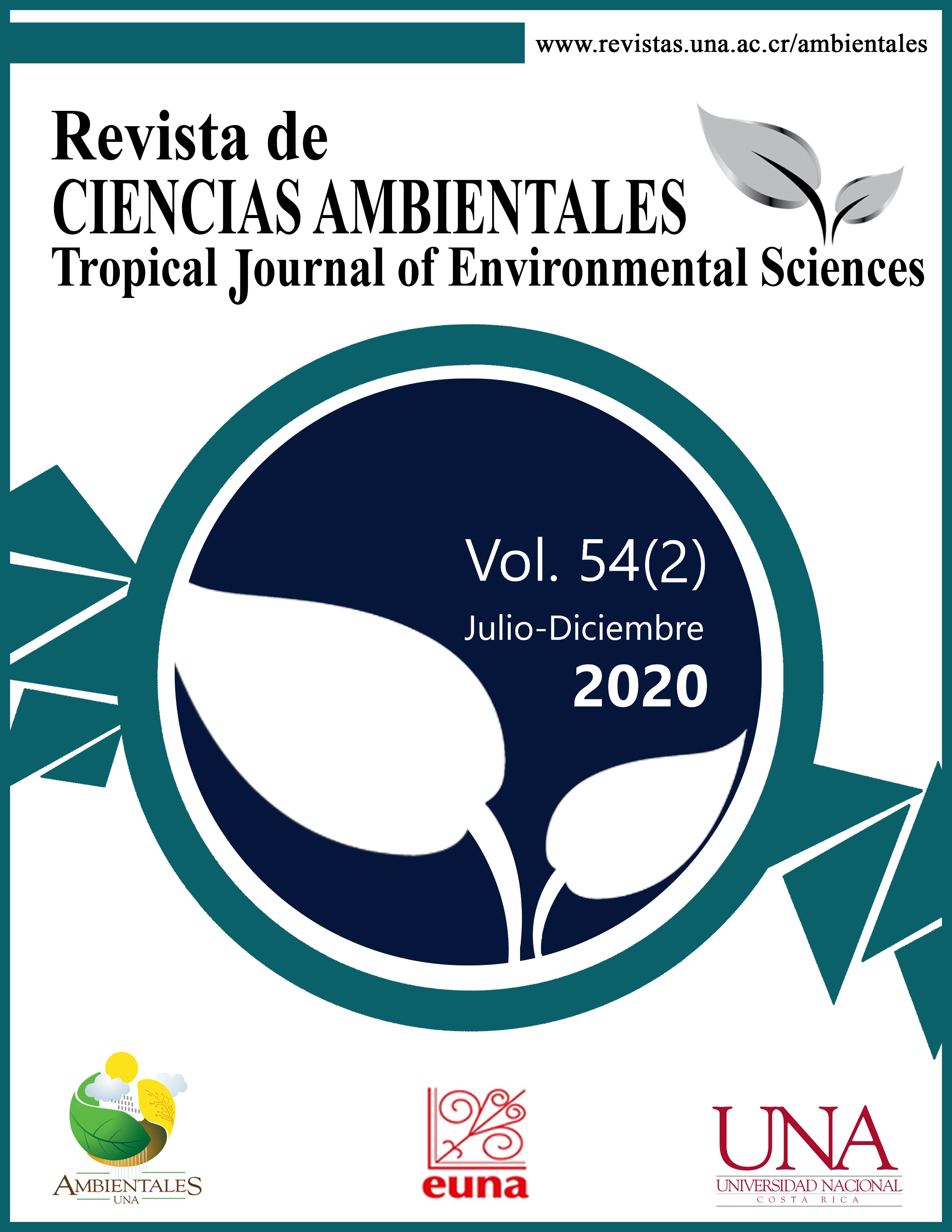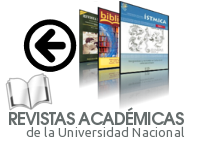Secondary Tropical Dry Forests Are Important to Cattle Ranchers in Northwestern Costa Rica
DOI:
https://doi.org/10.15359/rca.54-2.2Keywords:
Browsing; Cattle ranching; Ecosystem-based adaptation; Mesoamerican Dry Corridor; Seasonally dry tropical forests.Abstract
[Introduction]: In the dry regions of Central America, forests in cattle ranches are used as a refuge for cattle during the dry season, and there is no much information about this practice. [Objective]: to determine the frequency of this practice and how it fits in farm management. [Methodology]: We conducted semi-structured interviews with cattle ranchers in 43 farms in Liberia County, Guanacaste, Costa Rica. [Results]: Cattle farmers suffered from the loss of profitability due to droughts, fire, and cattle theft. Cattle browsing in the forest was used by 70 % of farms, mostly between March and May. No type of farm or feeding strategy was associated with forest browsing. The high variability in farm management did not provide a distinct classification of feeding strategies. We found a difference in farm structure and feed types between ranches in the plains and mountain slopes. The decision to use forests for browsing seemed to rely on a trade-off between animal welfare and ease of management. Traditional knowledge about cattle behavior in forests was variable and often limited to forest edges and pastures. [Conclusions]: This research shows that forests should be taken into consideration when analyzing cattle ranching in dry regions of Central America. We recommend a further study on feeding strategies and the impact of cattle on forest integrity to determine if agricultural policymakers should foster these low-costs alternatives.
References
Aganga, A. A., & Tshwenyane, S. O. (2003). Feeding Values and Anti -Nutritive Factors of Forage Tree Legumes. Pakistan Journal of Nutrition, 2(3), 170–177. https://doi.org/10.3923/pjn.2003.170.177
Andrade Pérez, Á., Herrera Fernández, B., & Cazzolla Gatti, R. (2010). Building Resilience to Climate Change: Ecosystem-based adaptation and lessons from the field. Ecosystem Management Series no. 9. Gland, Switzerland: IUCN.
Ascencio-Rojas, L., Valles-de la Mora, B., & Ibrahim, M. (2013). Use and management of tree fodder resources on farms in central Veracruz, Mexico. Avances En Investigación Agropecuaria, 17(1), 95–117.
Barrientos-Ramírez, L., Vargas-Radillo, J. J., Segura-Nieto, M., Manríquez-González, R., & López-Dellamary Toral, F. A. (2015). Nutritional evaluation of mature seeds of Enterolobium cyclocarpum (parota) from diverse ecological zones in western Mexico. Bosque (Valdivia), 36(1), 95–103. https://doi.org/10.4067/S0717-92002015000100010
Belsky, A. J., & Blumenthal, D. M. (1997). Effects of Livestock Grazing on Stand Dynamics and Soils in Upland Forests of the Interior West. Conservation Biology, 11(2), 315–327. https://doi.org/10.1046/j.1523-1739.1997.95405.x
Bergoeing, J. P. (2017). Geomorphology and volcanology of Costa Rica. San Jose, Costa Rica: Elsevier. https://www.sciencedirect.com/book/9780128120675/geomorphology-and-volcanology-of-costa-rica
Betancourt, K., Ibrahim, M., Harvey, C. A., & Vargas, B. (2003). Efecto de la cobertura arbórea sobre el comportamiento animal en fincas ganaderas de doble propósito en Matiguás , Matagalpa, Nicaragua. Agroforestería En Las Américas, 10, 47–51. http://bco.catie.ac.cr/portal-revistas/index.php/RAFA/article/viewFile/858/1343
Cabrera, R. P. (2007). Tierra y Ganaderia en Guanacaste (1st ed.). Cartago, Costa Rica: Editorial Tecnológica de Costa Rica.
Di Rienzo, J. A., Casanoves, F., Balzarini, M. G., Gonzalez, L., Tablada, M., & Robledo, C. W. (2018). InfoStat versión 2018. Argentina: Facultad de Ciencias Agropecuarias, Universidad Nacional de Córdoba. http://www.infostat.com.ar
Elshahawy, I., & Aly, M. (2016). Some Studies on Deviated Appetite (Pica) in Cattle. Alexandria Journal of Veterinary Sciences, 51(1), 97. https://doi.org/10.5455/ajvs.241117
FAO. (2016). Grassland Index. A searchable catalogue of grass and forage legumes. https://web.archive.org/web/20161230072508/http://www.fao.org/ag/agp/agpc/doc/gb.
Franzel, S., Carsan, S., Lukuyu, B., Sinja, J., & Wambugu, C. (2014). Fodder trees for improving livestock productivity and smallholder livelihoods in Africa. Current Opinion in Environmental Sustainability, 6(1), 98–103. https://doi.org/10.1016/j.cosust.2013.11.008
Fung, E., Imbach, P., Corrales, L., Vilchez, S., Zamora, N., Argotty, F., … Ramos, Z. (2017). Mapping conservation priorities and connectivity pathways under climate change for tropical ecosystems. Climatic Change, 141(1), 77–92. https://doi.org/10.1007/s10584-016-1789-8
Garcia-Cruz, F., Ibrahim, M., & Pezo, D. (2013). Los árboles en los potreros para la reducción del estrés calórico del ganado en los trópicos. In D. Sánchez, C. Villanueva, G. Rusch, M. Ibrahim, & F. De Clerck (Eds.), Estado del recurso arbóreo en fincas ganaderas y su contribución en la producción en Rivas, Nicaragua. (Costa Rica, pp. 36–41). Turrialba: CATIE.
Gei, M., Rozendaal, D. M. A., Poorter, L., Bongers, F., Sprent, J. I., Garner, M. D., … Powers, J. S. (2018). Legume abundance along successional and rainfall gradients in Neotropical forests. Nature Ecology and Evolution, 1–10. https://doi.org/10.1038/s41559-018-0559-6
IMN. (2013). Descripcion del Clima: Canton de Liberia. San Jose, Costa Rica: MINAE.
INEC. (2014). VI Censo Nacional Agropecuario, 170. http://www.mag.go.cr/bibliotecavirtual/U40-10581.pdf
Janzen, D. H., & Hallwachs, W. (2016). Conservación de la Biodiversidad -Su Historia y Su Futuro en Costa Rica: El Caso del Área de Conservación Guanacaste (ACG). In M. Kappelle (Ed.), Costa Rican Ecosystems (pp. 290–341). Chicago: The University of Chicago Press.
Kalacska, M., Sanchez-Azofeifa, G. A., Calvo-Alvarado, J. C., Quesada, M., Rivard, B., & Janzen, D. H. (2004). Species composition, similarity and diversity in three successional stages of a seasonally dry tropical forest. Forest Ecology and Management, 200(1–3), 227–247. https://doi.org/10.1016/j.foreco.2004.07.001
Klemens, J. A., Deacon, N. J., & Cavender-Bares, J. (2011). Pasture Recolonization by a Tropical Oak and the Regeneration Ecology of Seasonally Dry Tropical Forests. In Seasonally Dry Tropical Forests (pp. 221–237). Washington, DC: Island Press/Center for Resource Economics. https://doi.org/10.5822/978-1-61091-021-7_13
Lascano, C. E. (2000). Selective grazing on grass-legume mixtures in tropical pastures. In G. Lemaire, J. Hodgson, A. de Moraes, C. Nabinger, & P. C. de F. Carvalho (Eds.), Grassland ecophysiology and grazing ecology (pp. 249–263). Wallingford, UK: CABI. https://doi.org/10.1079/9780851994529.0249
Le Houerou, H. N. (1980). Browse in Africa: the current state of knowledge. (H. N. Le Houerou, Ed.). Addis Ababa, Ethiopia: ILCA. https://cgspace.cgiar.org/handle/10568/67392
Miles, L., Newton, A. C., DeFries, R. S., Ravilious, C., May, I., Blyth, S., … Gordon, J. E. (2006). A global overview of the conservation status of tropical dry forests. Journal of Biogeography, 33(3), 491–505. https://doi.org/10.1111/j.1365-2699.2005.01424.x
Espinoza, F. (2012). Comportamiento y selectividad de bovinos en crecimiento utilizando el bosque caducifolio. Mundo Pecuario, VIII(1), 49–59.
Murphy, P. G., & Lugo, A. E. (1995). Dry forests of Central America and the Caribbean. In S. H. Bullock, H. A. Mooney, & E. Medina (Eds.), Seasonally Dry Tropical Forests (pp. 9–34). Cambridge: Cambridge University Press. https://doi.org/10.1017/CBO9780511753398.002
Olson, D. M., Dinerstein, E., Wikramanayake, E. D., Burgess, N. D., Powell, G. V. N., Underwood, E. C., … Kassem, K. R. (2001). Terrestrial Ecoregions of the World: A New Map of Life on Earth: A new global map of terrestrial ecoregions provides an innovative tool for conserving biodiversity. BioScience, 51(11), 933–938. https://doi.org/10.1641/0006-3568(2001)051[0933:teotwa]2.0.co;2
Pérez Almario, N., Ibrahim, M., Villanueva, C., Skarpe, C., & Guerin, H. (2013). Diversidad forrajera tropical 1: Selección y uso de leñosas forrajeras en sistemas de alimentación ganadera para zonas secas de Nicaragua. Agroforestería En Las Américas, 50, 37–43. http://hdl.handle.net/11250/2467520
Pezo, D., & Ibrahim, M. (1998). Sistemas silvopastoriles. Módulo de Enseñanza Agroforestal No. 2. Turrialba, Costa Rica: Proyecto Agroforestal CATIE-GTZ.
Sánchez-Azofeifa, A., Calvo-Alvarado, J., Marcos do Espírito-Santo, M., Fernandes, G., Powers, J., & Quesada, M. (2013). Tropical Dry Forests in the Americas: The Tropi-Dry Endeavor. In Tropical Dry Forests in the Americas: Ecology, Conservation, and Management (pp. 1–15). Boca Raton, Fla.: CRC Press. https://doi.org/10.1201/b15417-2
Sánchez-Azofeifa, G. A., Quesada, M., Rodríguez, J. P., Nassar, J. M., Stoner, K. E., Castillo, A., … Cuevas-Reyes, P. (2005). Research priorities for neotropical dry forests. Biotropica, 37(4), 477–485. https://doi.org/10.1046/j.0950-091x.2001.00153.x-i1
Simón, M., Ibrahim, M., Finegan, B., & Pezo, D. (1998). Efectos del pastoreo bovino sobre la regeneración de tres especies arbóreas comerciales del chaco argentino: un método de protección. Agroforestería En Las Américas, 5, 84–87.
Stan, K., & Sanchez-Azofeifa, A. (2019). Deforestation and secondary growth in Costa Rica along the path of development. Regional Environmental Change, 19(2), 587–597. https://doi.org/10.1007/s10113-018-1432-5
Stern, M., Quesada, M., & Stoner, K. E. (2002). Changes in composition and structure of a tropical dry forest following intermittent cattle grazing. Revista de Biología Tropical, 50(3–4), 1021–1034. http://www.ncbi.nlm.nih.gov/pubmed/12947586
Vásquez, F., Mora, J., & Aguilar-støen, M. (2014). Saber Popular De Especies Forrajeras En La Zona Central De Nicaragua : Un Estudio En Grupos Focales. Revista de Ciencias Agricolas, 31(1), 27–41. https://doi.org/10.22267/rcia.143101.43
Vieira, D. L. M., Scariot, A., & Holl, K. D. (2006). Effects of habitat, cattle grazing and selective logging on seedling survival and growth forest of central Brazil. Biotropica, 39(2), 269–274. https://doi.org/10.1111/j.1744-7429.2006.00246.x
Published
How to Cite
Issue
Section
License

This work is licensed under a Creative Commons Attribution-NonCommercial-ShareAlike 4.0 International License.



















